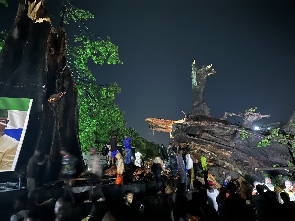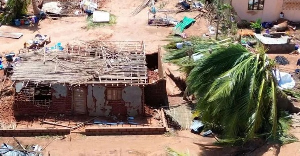The Sierra Leone government has reacted to the destruction of a historic and iconic tree that stands in the middle of the capital, Freetown.
President Julius Maada Bio confirmed via a tweet, reports in local media, that the cotton tree had been felled due to heavy downpour in Freetown on May 24.
"The iconic Cotton Tree has fallen due to the heavy downpour of rain in our capital this evening. A great loss to the nation. It was regarded as a symbol of liberty and freedom by early settlers.
"We will have something at the same spot that bears testament to the great Cotton Tree's place in our history. All voices will be brought together for this," the tweet added.
"Freetown’s most iconic landmark is gone. The city’s Chief Administrator, Festus Kallay, says the towering Cotton Tree - hundreds of years old - has just been brought down by a heavy storm. It’s a huge vacuum in the city’s skyline," a BBC journalist, Umaru Fofana tweeted.
Sierra Leoneans on social media have been sharing photos of the fallen tree which according to history dates back to the 1700s, reminding of the country's colonial past, its history and resilience.
The iconic Cotton Tree has fallen due to the heavy downpour of rain in our capital this evening. A great loss to the nation. It was regarded as a symbol of liberty and freedom by early settlers. We will have something at the same spot that bears testament to the great Cotton…
— President Julius Maada Bio (@PresidentBio) May 24, 2023
About the Cotton Tree - Credit Atlas Acura
THE HISTORIC SYMBOL OF FREETOWN, the capital of Sierra Leone, is a large kapok tree known as the “Cotton Tree.” According to legend, the tree gained importance in 1792 when a group of formerly enslaved people settled the site of what is now Freetown.
After the American Revolution, the British granted freedom to the enslaved people who had fought with the Crown during the war. Some so-called “Black Loyalists” were given land and supplies to resettle in British-controlled Nova Scotia, while others went to London and parts of the Caribbean.
In 1787, some 4,000 formerly enslaved people were resettled in Sierra Leone—regardless of where they or their ancestors had originally come from. Five years later, another group emigrated from Nova Scotia to Sierra Leone.
According to the story, when the first boat arrived, they walked up to a large tree just above the bay and held a Thanksgiving service there, praying and singing hymns.
That tree still stands, (has fallen as of May 24), it stood between the courthouse and the National Museum. Though its exact age is unknown, it is known to have existed in 1787 and believed to be the oldest cotton tree in the nation. The Cotton Tree is an iconic monument in the capital and appears on the 10,000 Leones banknotes.
The passing of many an iconic Sierra Leonean has been likened to the falling of a big tree. How then do we describe the falling of #SierraLeone’s most recognisable landmark and greatest icon? RIP the Cotton Tree. pic.twitter.com/spekaaHzAr
— Sheka Forna (@tonkolili) May 24, 2023
The world must achieve a sharp drop in global warming in the next 8yrs, if the natural calamities we have seen recently across the globe are not to get worse. The fall of the Cotton Tree in Freetown should therefore reenergize our efforts to address climate change issues in ???????? pic.twitter.com/Z5KSYqJADH
— Babatunde Ahonsi (@AhonsiBA) May 25, 2023
You can also watch the latest episode of People & Places:
Meanwhile, watch the latest episode of SayItLoud on GhanaWeb TV below:

SARA
Due to the heavy downpour of rain this night, the famous, historic and iconic cotton tree that was once standing tall at the center of Freetown, the capital of Sierra Leone, has fallen after 200+ years of existence. ????#SaloneTwitter #SierraLeone #Freetowncottontree pic.twitter.com/14Tyvb0lhK
— The African Dream (@theafricadream) May 24, 2023
You can also watch the latest episode of People & Places:
Meanwhile, watch the latest episode of SayItLoud on GhanaWeb TV below:

SARA




















